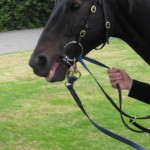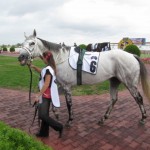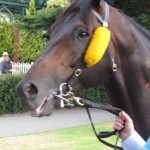I have trained my eye to instantly assess a horse for over a hundred different variables, mostly related to behaviour and gear. But there are still things that I miss. Fortunately I can rely on other eyes, and when my mate Peter said have you seen the Irish martingale on Fabulist, I had to confess that I had missed it. I whipped out the camera for a quick snap of the horses head, just hoping to catch it. I’m afraid I failed pretty comprehensively. But if you have a good look at the picture you can get a glimpse of the rings on the reins in the bottom right-hand corner.
- Fabulist
- Stanzout
- God Has Spoken
An Irish martingale is simply a short strap with a ring on either end. The reins are run through the ring on each side. According to Wikipedia “the Irish martingale’s purpose is not to control the head, but to prevent the reins from coming over the horse’s head, risking entanglement, should a rider fall”. This seemed like a bit of nonsense so after the race I hurried back to the stall to check with Danny O’Brien. Danny said that the rings just put a bit of weight on the reins and get the horse’s head down a bit. He also said they are often used in track gallops. I could see why Fabulist could benefit because the mare was very much a head-up, unsettled type of horse. But to no avail though, when the horse finished fourth of seven runners.
Not much else caught my eye. Stanzout, who used to be a beautiful dappled grey is now almost completely white, but retaining the dapples on his legs, front and back. If you do a search for Stanzout in the Search box you can see how he looked on Cox Plate day in 2010. Age gets to us all. I’ve even found a few white hairs in unmentionable places as well.
And God Has Spoken was sporting very spiffy yellow winkers. I can’t recall seeing this colour on a horse before, but it is probably appropriate. Horses have what is known as dichromatic colour vision, in contrast to humans who have trichromatic vision. Horses can see blue and yellow, but not red and green. They probably perceive the world in much the same way as a red-green colour blind human. God Has Spoken finished eleventh of fourteen. He was obviously too distracted by a colour that he could actually see out of the corner of his eye.





